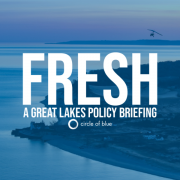FRESH, July 26, 2022: Citizens Divided Over Wind Energy in Lake Erie
July 26, 2022
Fresh is a biweekly newsletter from Circle of Blue that unpacks the biggest international, state, and local policy news stories facing the Great Lakes region today. Sign up for Fresh: A Great Lakes Policy Briefing, straight to your inbox, every other Tuesday.
— Laura Gersony, Fresh Editor
This Week’s Watersheds
- The Great Lakes Water Authority denies 24,000 insurance claims from floods in Michigan last summer.
- A Chicago Tribune investigation finds PFAS chemicals widespread across Illinois.
- New York residents are divided over a proposal to build wind turbines in Lake Erie.
- Wisconsin’s attorney general sues 18 chemical manufacturers over PFAS contamination.
In Ohio, toxic algal blooms are hiking the cost of water.
“We as the consumer have the burden of paying for a lack of regulation, mandates, and policies on water contamination.”— Alicia Smith, director of Junction Coalition, a community action group in Toledo, Ohio.The costs of cleaning up toxic algae are falling on Ohio ratepayers, Grist reports. In its waters, the state has long battled cyanobacteria blooms whose growth is fuelled by excess nitrogen and phosphorus, largely from agricultural runoff. Treating the polluted water costs an estimated $19 per person per year. Climate change is expected to intensify harmful algal blooms, as increased rainfall in the Midwest washes more nutrients into the Great Lakes. Community advocates are dueling with the state over whether to implement mandatory limits on nutrient pollution from large-scale agriculture operations.
Fresh from the Great Lakes News Collaborative
- Industries and public water supplies top the list of main consumers of Great Lakes water — Michigan Radio
- State outdoors operations emerge stronger after the pandemic — Great Lakes Now
As the nation prepares to pour hundreds of billions of dollars into rescuing water systems, The Great Lakes News Collaborative investigates the true cost of water in Michigan. Catch up on this 10-part series here.
The Great Lakes News Collaborative includes Bridge Michigan; Circle of Blue; Great Lakes Now at Detroit Public Television; and Michigan Radio, Michigan’s NPR News Leader. We work together to produce news and information about the impact of climate change, pollution, and aging infrastructure on the Great Lakes and drinking water. This independent journalism is supported by the Charles Stewart Mott Foundation. Find all the work here.
Great Lakes Water Authority Finds Detroit Not Responsible for Floods
The Great Lakes Water Authority has denied about 24,000 insurance claims filed after Michigan’s floods last year, the Detroit Free Press reports. Hammering June rains backed up sewers, flooded streets, and damaged hundreds of homes in Detroit and its suburbs. Under state law, the city can be held responsible if failures by government officials caused at least half of the damages. An independent analysis found that while electrical problems at wastewater pumping systems exacerbated the sewer backups, most of the devastation was due to heavy rainfall, not government failure.
- Why it matters: The risk assessments that were used to build Detroit’s infrastructure are starting to break down. Extreme rain events are becoming heavier and more frequent across the Midwest as Earth’s atmosphere warms. Last summer, Circle of Blue reported on how Detroit’s water systems were not built for current or future climate pressures.
In the News
PFAS: An investigation by the Chicago Tribune found that about 8 million Illinois residents get their water from a utility where “forever chemicals” have been detected. The Tribune located 1,654 potential sources of the chemicals, which a growing body of research links to adverse health effects. The chemicals have been found at worrisome concentrations in and around Chicago, as well as in water systems and rivers downstate. While federal regulation is on the way, the state of Illinois currently does not regulate PFAS in drinking water.
WIND ENERGY: A wind farm has emerged as the latest energy flashpoint in New York, the Buffalo News reports. Citizens are divided over a proposal to put a new wind farm on the shores of Lake Erie. While supporters laud the plan as an opportunity to produce clean energy, opponents fear that the plant could harm water and wildlife. The project would mark the first freshwater wind farm in North America, though such farms are common elsewhere in the world. A New York energy department will soon release a plan evaluating the risks of wind development in the Great Lakes.
Looking Ahead
PFAS LAWSUIT: Wisconsin Attorney General Josh Kaul filed a lawsuit against 18 companies for their role in manufacturing PFAS chemicals that have polluted the state’s waterways, the Associated Press reports. Filed in Dane County Circuit Court, the lawsuit seeks damages and to recover the cost of investigating and cleaning up contaminated sites. The lawsuit alleges that the companies – including 3M and Tyco Fire Products – knew or should have known the health and environmental risks that their products posed.
Upcoming Events
- July 27, 2022: Upcoming Public Meeting Webinar for the Niagara River/ Lake Erie Watershed Management Plan – register
- July 28, 2022: Webinar: Using Bacteria to Remove Microcystin from Drinking Water — register
- August 22-24, 2022: Conference, Aquatic Ecosystems Health and Management Society: “The Ecosystem Approach in the 21st Century: Guiding Science and Management” — register
- August 25, 2022: National Writers Series: Dave Dempsey and Jerry Dennis on protecting the Great Lakes — register
- October 11-13, 2022: Great Lakes Commission Annual Meeting – register
Other News
- A Pennsylvania judge blocks a rule that would limit carbon emissions from power plants.
- Michigan’s state budget will give fisheries a $30 million boost.
- Wisconsin residents accuse a state agency of allowing loggers to harvest too close to a lake shoreline.
Laura Gersony covers water policy, infrastructure, and energy for Circle of Blue. She also writes FRESH, Circle of Blue’s biweekly digest of Great Lakes policy news, and HotSpots H2O, a monthly column about the regions and populations most at-risk for water-related hazards and conflict. She is an Environmental Studies and Political Science major at the University of Chicago and an avid Lake Michigan swimmer.











Leave a Reply
Want to join the discussion?Feel free to contribute!